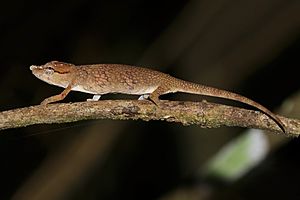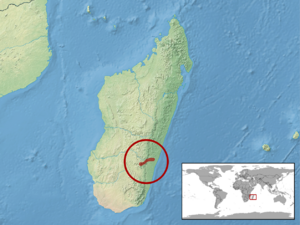Deceptive chameleon facts for kids
Quick facts for kids Deceptive chameleon |
|
|---|---|
 |
|
 |
|
| Both in Ranomafana National Park | |
| Conservation status | |
| Scientific classification | |
| Genus: |
Calumma
|
| Species: |
fallax
|
 |
|
| Synonyms | |
|
Chamaeleon fallax Mocquard, 1900 |
|
The deceptive chameleon, also known as the short-nosed deceptive chameleon, is a special type of chameleon. Its scientific name is Calumma fallax. This amazing creature lives only in eastern Madagascar, which is an island country off the coast of Africa. It was first discovered and described in 1900.
Contents
Where Does This Chameleon Live?
The deceptive chameleon is found only in eastern Madagascar. Its first known home was the Ikongo forest. These chameleons live in forests at a middle altitude. Scientists believe they might live across an area of about 2,057 square kilometers (about 794 square miles).
Why Is It Hard to Study?
The International Union for Conservation of Nature (IUCN) has listed this chameleon as "data deficient". This means we don't have enough information about it. Scientists don't know how many deceptive chameleons there are. They also don't know if their numbers are going up or down.
What Threats Does It Face?
The places where these chameleons live are changing. People sometimes use a farming method called slash-and-burn, which clears forests. Bushfires and logging (cutting down trees) also affect their homes. Sometimes, these chameleons are even taken for the pet trade.
What Does the Deceptive Chameleon Look Like?
The deceptive chameleon is a medium-sized chameleon. Both male and female chameleons are about the same size.
How Big Do They Get?
From their snout (nose) to their vent (a small opening near the tail), males usually measure between 43 to 51 millimeters (about 1.7 to 2 inches). Females are similar, measuring 41 to 51 millimeters (about 1.6 to 2 inches). The longest they can get, including their tail, is about 107 millimeters (about 4.2 inches).
How Was This Chameleon Named?
The deceptive chameleon was first described in 1900 by a scientist named Mocquard. He first called it Chamaeleon fallax. Later, in 1986, other scientists moved it to a different group, or genus, called Calumma. Since then, it has been known as Calumma fallax.


